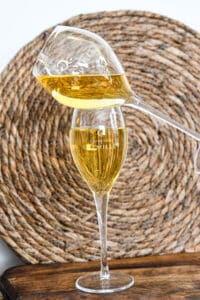
COMPOSITION OF CHAMPAGNE – OENOLOGICAL PARTICULARITIES
When discussing the composition of Champagne, one inevitably thinks of the three grape varieties that account for 99% of production: Pinot Noir, Meunier, and Chardonnay.
What Percentage of Alcohol Is in Champagne? How Is the Alcohol Content in a Glass Composed? One thing is certain: it should be enjoyed in moderation! To make the pleasure of the bubbles last!
SUMMARY
– 12 Degrees on Average of Alcohol in Champagne
– When Does Alcohol Appear in Champagne?
– Is There Less Alcohol in Lower-Dosed Champagnes?

Most Champagnes have an alcohol content of 12 degrees, 12 and a half degrees. This is slightly less on average than red wine, which typically has an alcohol content between 12 and 14 degrees, or even more for rare exceptions. In pure volume, alcohol represents 100 to 120 ml of alcohol per liter, or 80 ml for a 750 ml bottle of Champagne. Several types of alcohol make up this volume: ethanol, glycerol, propanol… The highest percentage of alcohol in Champagne is provided by ethanol, which plays a major role in preservation. These names might seem “harsh,” but they are essential to Champagne and the tasting experience. Champagnes produced a century ago had a lower alcohol content, around 9%. This significant difference could be due to climate variations between the past and today. Grape ripening was slower due to the cooler temperatures of the time, and the yeasts were less efficient than those of our era, which are more sophisticated. Knowledge and experience have come a long way.
On our site, we describe the winemaking process step by step. While Champagne enthusiasts know it by heart, some of you may discover a few production secrets! And to see things firsthand, there’s nothing like a visit to the estate in Balnot-sur-Laignes, near Les Riceys, in the Côte des Bar, in the southern Champagne region. One of the first stages of winemaking after pressing and an initial clarification of the juice is alcoholic fermentation. The pressing of 4000 kg of grapes will yield exactly 20.50 HL of juice called Cuvée and 5HL of taille. All our Champagnes come from the first pressing, the “cuvée,” and only from it, which provides greater aging potential. Once in the vat, the process of alcoholic fermentation begins. The different yeasts transform sugar into alcohol and carbon dioxide. The must gradually turns into wine. The magic starts to happen! The goal is not to exceed 11° at the end of fermentation. The alcohol content will increase slightly during the second fermentation, this time in the bottle, which is the « prise de mousse, » or the creation of bubbles.
The alcohol content of a cuvée remains the same from one to another. One must not confuse the alcohol content, which is fixed permanently at the end of alcoholic fermentation in the vat, with the dosage of liqueur, which at the time of disgorgement determines the type of Champagne. The dosage liqueur, also known as the expedition liqueur, affects the sugar content of the Champagne. Its concentration, more or less intense, will result in a sweet, demi-sec, sec, extra dry, brut, or extra brut Champagne, all of which will have an alcohol content of around 12°. Moreover, the specifications for the Champagne appellation do not allow an alcohol content higher than 13°. This alcohol level places Champagne among the wines with the lowest alcohol content, but it should still be enjoyed with pleasure AND moderation.


When discussing the composition of Champagne, one inevitably thinks of the three grape varieties that account for 99% of production: Pinot Noir, Meunier, and Chardonnay.

For many decades, the production of Champagne has followed a precise and well-established process. The making of Champagne respects traditions and practices, which Maison Gremillet

Understanding the Difference Between Non-Vintage Brut Champagne and Vintage Champagne. The world of Champagne is vast and varied, offering a multitude of choices for wine